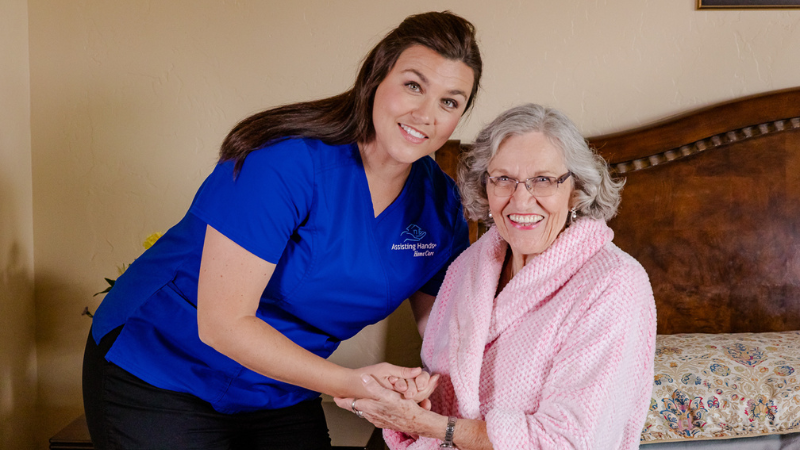

In the intricate tapestry of daily self-care, bathing is a fundamental thread that weaves together hygiene, well-being, and health. For many, the act of stepping into a shower or bathtub is a routine task, a moment to rejuvenate both body and spirit. However, the reality is that as time passes, age can gently erode the ability and desire to independently partake in these traditional bathing rituals. When the path to the shower or tub becomes a challenging journey, a bed bath emerges as not just an alternative but often the only viable option.
In this blog, we’ll explore why bed baths are important for some seniors, highlighting the specific situations where they become necessary. You can also look forward to a step-by-step guide on how to give a bed bath effectively. Moreover, we’ll extend our discussion to senior home care, emphasizing the important role caregivers play in establishing a supportive and nurturing environment for your elderly loved ones.
Why do Seniors Need Bed Baths?
As seniors age, they grapple with a range of physical and mental challenges that can contribute to a reluctance or fear of bathing. Several factors may contribute to this apprehension, including:
- Less Mobile: Getting in and out of regular baths or showers can be tough for many seniors because of mobility issues linked to conditions like paralysis, cerebral palsy, stroke, multiple sclerosis, muscular dystrophy, osteoporosis, and spinal cord injury. This underlines the need for simpler options like bed baths, offering a more accessible and comfortable bathing solution without requiring too much movement.
- Fatigue and Weakness: As we get older, we often feel more tired and weaker, making it harder to step into a bathtub or shower. This increased fatigue can make regular bathing methods difficult for seniors. Bed baths offer a simpler solution, especially for those who may not have the energy for the usual bathing routines.
- Cognitive Impairments: For seniors facing cognitive impairments, such as dementia, the experience of traditional bathing can be confusing and distressing. The familiarity of water-related activities becomes a source of anxiety due to forgetfulness. This emphasizes the importance of adopting more compassionate approaches, such as bed baths, to ensure a comfortable and reassuring hygiene routine for those with cognitive impairments.
- Sensory Issues: As our loved one’s age, they may discover that alterations in sensory abilities, like diminished vision or hearing, can transform the familiar bathing environment into an uncomfortable or disorienting space. This unease extends beyond the physical challenges of bathing and has the potential to impact their overall well-being. Moreover, sensory issues might lead to a reluctance or avoidance of water-related activities.
Step by Step Process on Giving Bed Bath to Your Senior
When it comes to giving a bed bath, it’s not just a task—it’s an opportunity to connect and show care. This simple guide is here to make the routine more thoughtful. Prepare well and go through each step with care.

Preparations for the Bed Bath
While preparing for the bed bath, You need a list of following materials, such as:
- Clean towels
- Soft washcloths or sponge
- Mild soap and lotion
- Basin or tub filled with warm water
- Disposable gloves
- Waterproof sheet
The Process of Giving a Bed Bath to Seniors
- To begin the bed bath, start by walking your senior loved one through each step, making sure they are at ease and well-informed about the process.
- Maintain their privacy by covering areas not currently being cleaned with towels or blankets, preserving a sense of dignity throughout the entire process.
- Kick off the routine by tending to the face: dampen a washcloth, add a bit of mild soap, and gently cleanse the face. Pay special attention to the eyes, nose, and mouth for a thorough yet gentle cleaning.
- Move on to the upper body, giving a thorough but gentle wash to the chest, arms, and underarms. Be mindful of nooks and crannies, ensuring a comfortable experience.
- Transition to the lower body, taking extra care of the genital areas. Use a fresh washcloth for this part, emphasizing hygiene and comfort.
- Extend the care routine to include the hands and feet. Check for any skin issues and trim nails cautiously, prioritizing their comfort to avoid any discomfort.
- When it’s time to shampoo the hair, take a gentle approach. Wet the hair, apply a small amount of shampoo, and delicately massage the scalp. Rinse thoroughly for a refreshing experience. If your senior has eye issues, consider using ready-to-use shampoo caps that don’t require water. Gently place the cap on their head, massage the scalp, and when you remove it, the hair is wet and moist.
- Throughout each step, keep your focus not only on cleanliness but also on creating a compassionate and respectful experience for your loved ones.
- Once the bath is complete, gently apply an unscented body lotion. This not only helps protect the skin but also maintains its moisture, ensuring a comfortable and nourished feeling.
Seek a Caregiver for Help

If you’re finding it tough to help your senior loved one with bed baths, don’t worry. At Assisting Hands Home Care in The Villages, Florida, our skilled caregivers specialize in providing caring companion care and personalized services for seniors. They’re here to make sure your loved ones feel comfortable and well-supported. Whether it’s assisting with bathing or offering friendly companionship, our caregivers play an essential role in improving every seniors’ quality of life. If you want more details about our senior home care services at Assisting Hands, feel free to call us at (352) 758-4512.
